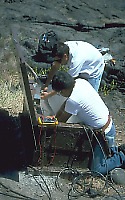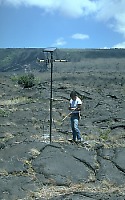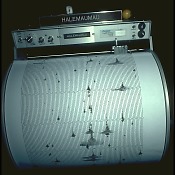
|
|
|

|

|
| HVO electronic technicians upgrading seismic network | |
Earthquakes in Hawai`i are closely linked to volcanism. They are an important part of the island-building processes that have shaped the Island of Hawai`i and the other Hawaiian Islands. Thousands of earthquakes occur every year beneath the Island of Hawai`i.
Eruptions and magma movement within the presently active volcanoes (Kilauea, Mauna Loa and Lo`ihi) are usually accompanied by numerous small earthquakes. They originate in regions of magma storage or along the paths that magma follows as it rises and moves prior to eruption. These are loosely termed volcanic earthquakes.
Many other earthquakes, including the largest ones, occur in areas of structural weakness at the base of Hawai`i's volcanoes or deep within the Earth's crust beneath the island. These are referred to as tectonic earthquakes. In the past 150 years, several strong tectonic earthquakes (magnitude 6 to 8) caused extensive damage to roads, buildings, and homes, triggered local tsunami, and resulted in loss of life. The most destructive earthquake in Hawai`i's history occurred on April 2, 1868, when 81 people lost their lives. With a magnitude of 7.9 and a maximum intensity of XII, this destructive earthquake destroyed more than a hundred homes and generated a 15-m high tsunami along Kilauea's south coast.
 Seismograph
|
Along with other signs of volcanic activity, we monitor earthquakes and seismic activity on Hawai`i continuously and in real-time to provide warnings of impending eruption and to assess seismic hazards in the State of Hawai`i. |
Map of current earthquakes
This map of Hawai`i shows the location and size of earthquakes that have occurred in the past two weeks. For each earthquake, you can also retrieve a preliminary report and actual seismograms.
Felt earthquakes
This presentation introduces the differences between magnitude and intensity scales and provides links to a list of current felt Big Island earthquakes and a form for reporting felt earthquakes. Most earthquakes detected by our seismographic instrumentation are too small to be felt.
Destructive earthquakes
Highlights Hawai`i's historical, destructive earthquakes, including large events on 2 April 1868 and 29 November 1975.
Seismic hazards on the Island of Hawai`i
This presentation shows the current seismic zonation for the State of Hawai`i recommended by the Hawai`i State Earthquake Advisory Board; also see this online publication, Volcanic and Seismic Hazards on the Island of Hawai`i, reprinted in 1997.
HVO seismic instrumentation
A look at HVO's instrumentation and recording methods since 1950.
Hawaiian seismicity
A map of Hawai`i shows the location of earthquakes in the past 12 months. An illustration of different seismographs or seismic signals is also provided.Catalog of Hawaiian Earthquakes, 1823 – 1959 USGS Professional Paper 1623.
Post 1959 Hawaiian earthquakes can be searched online by date, latitude, longitude, and magnitude from a composite
earthquake catalog from US regional and national seismic networks.
Contact: hvowebmaster@usgs.gov
Updated: 18 June, 2001 (pnf)

